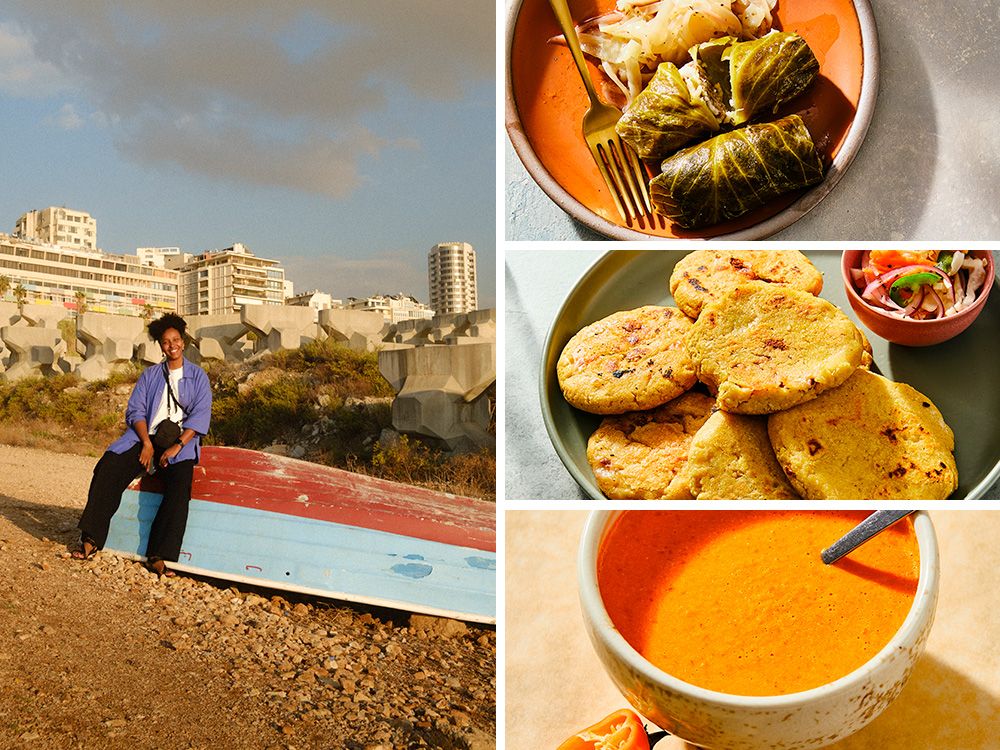
Our cookbook of the week is
Setting a Place for Us
by Hawa Hassan, a James Beard Award-winning author,
TV host
, and founder and CEO of
Basbaas
, a line of African-inspired sauces and condiments.
Jump to the recipes:
malfouf (
cabbage rolls
),
pupusas con curtido
(filled masa flatbreads with cabbage slaw) and
pili pili
(hot chili sauce).
Hawa Hassan drew on her own experiences as a refugee for her second cookbook, Setting a Place for Us. The
entrepreneur
travelled the world conducting interviews and researching the food cultures of eight countries affected by conflict: Afghanistan, the Democratic Republic of Congo (DRC), Egypt, El Salvador, Iraq, Lebanon, Liberia and Yemen.
Hassan understands life as a displaced person, having fled the Somali Civil War with her mother and siblings for a UN refugee camp across the Kenyan border in 1991. In Setting a Place for Us, she shares stories that take readers beyond reports of unrest and mass displacement, exploring the deep historical and cultural significance of the eight countries.
She notes that ancient Egypt was one of the world’s earliest societies, Mesopotamia (modern-day Iraq) is often called a “cradle of civilization,” and Lebanon has a rich history of trade and cultural exchange dating back to the Phoenicians.
“I was like, ‘OK, if I know these things to be true, and I can examine these countries that all have similarities to my own Somalia, what is a fuller story that can be told?’”
Hassan’s cookbook debut,
In Bibi’s Kitchen
(2020), also took a multinational approach, centring on grandmothers from eight African countries along the coast of the Indian Ocean: Eritrea, Somalia, Kenya, Tanzania, Mozambique, South Africa, Madagascar and Comoros.
“Since In Bibi’s Kitchen, it’s been really nice to see so many other people now doing books that aren’t just about single origin,” she says.
Setting a Place for Us came together during the pandemic, which put a damper on Hassan’s research trips. “Where I could go, and where we were allowed to go, we went.” She and location photographer
Riley Dengler
travelled to the DRC, El Salvador, Lebanon and Liberia. For the other four countries, Hassan collaborated with photographers on the ground.
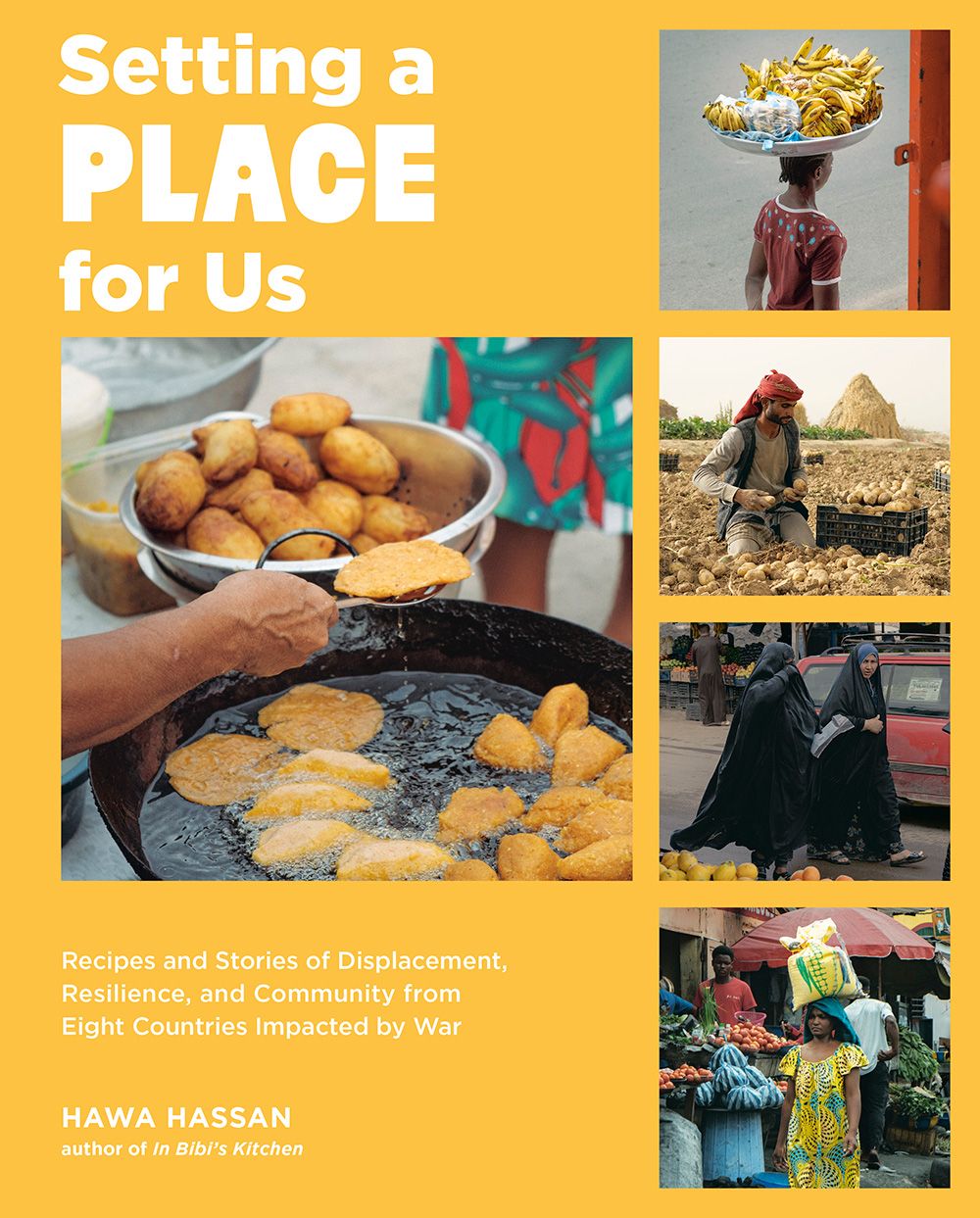
In researching the book and conducting interviews, Hassan found parallels, such as how her family greets guests and the way Iraqis often do, with tea and dates. “These things were just so incredibly refreshing to me,” says Hassan. “In interviewing people from the place, I learned so much, even about my own self and my own culture.”
Hassan was five years old when she, her mother — who was nine months pregnant — and three siblings sought refuge in the
Dadaab refugee complex
. At seven, then in Nairobi, her mother sent Hassan to live with a family friend in Seattle, Wash., telling her she would have more opportunities there.
“I know I’m not alone in this feeling that I’ve been abandoned, or that there is no home, or that though you’ve left a group of people behind, you’re going to start over, and what becomes of you in your new place is neither here nor there. That was the feeling I’d had my whole life — that I was othered in so many ways. I was, of course, a refugee, but I wasn’t around refugees. I was displaced, but I wasn’t displaced with my family.”
Setting a Place for Us was born out of a search to understand the experiences of other displaced people. Hassan says that in many ways, writing the book gave her closure on what it means to be from Somalia living abroad. The introduction opens like a memoir, and it was painful for her to write. She ended up saving it for last, approaching it with a new perspective after her travels.
“Visiting these countries and interviewing locals — documenting their food traditions and their daily routine — kind of zaps you out of your own reality. I think when you’re reporting on the ground, there’s a level of presence that’s required from you that takes you away from the need to always centre your own story. And so that was, in a lot of ways, very healing for me.”
Each chapter opens with an essay and a profile of a person who is preserving their culture. Hassan says that while writing the book, she found connections in ways she hadn’t before. People such as Beiruti Mikey Muhanna, founder of media and educational organization
Afikra
, “changed something in me.”
Hassan recalls asking Muhanna if immigrants can find communities where they can be their authentic selves. She’s kept his response with her ever since. “Absolutely,” he answered. “While the physical home might change, the essence of home — found in community, food and shared experiences — can always be rebuilt.”
MALFOUF
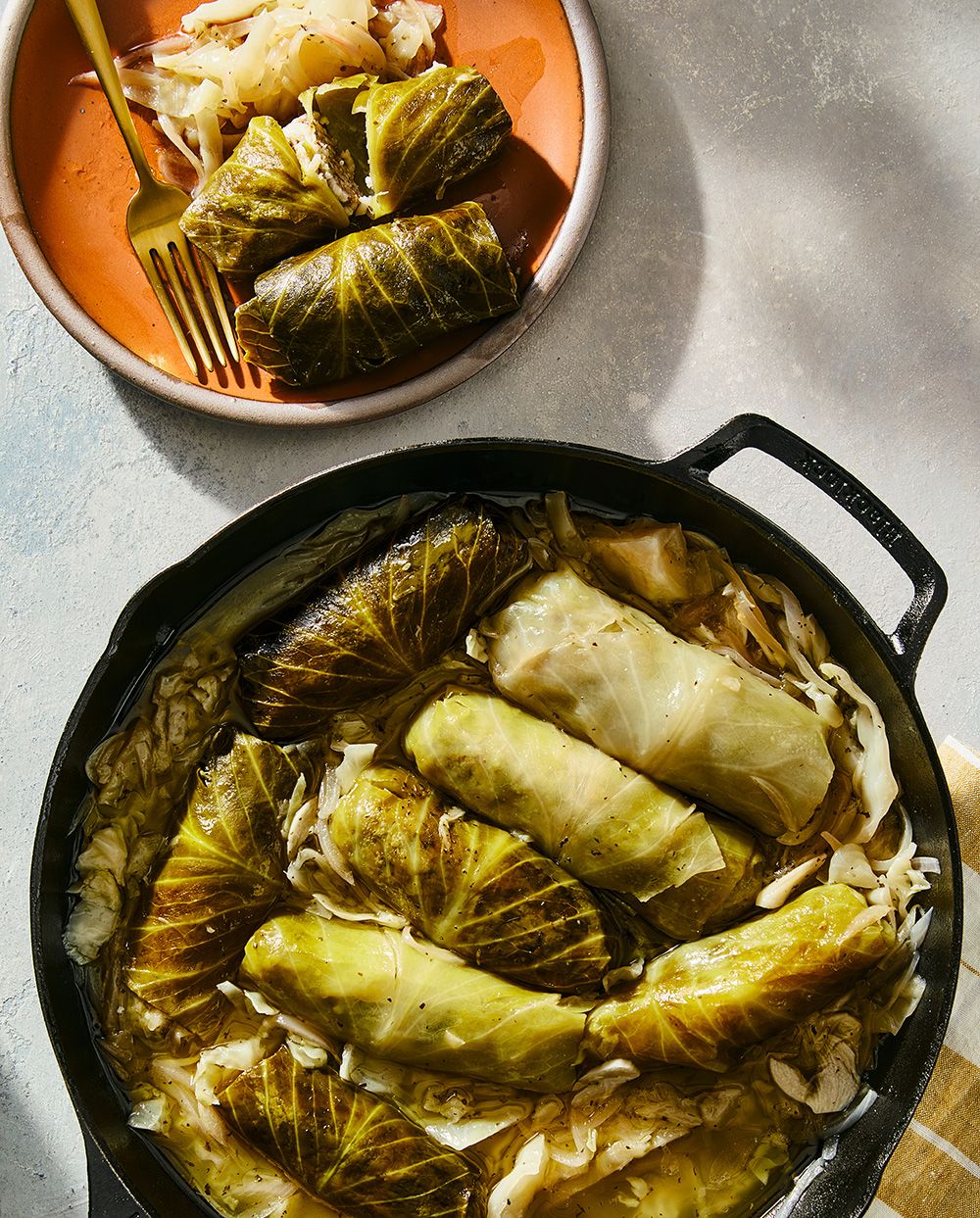
Cabbage Rolls
Makes:
about 15 rolls; serves 4 to 6
Kosher salt
1 large green cabbage
1 1/2 cups short-grain white rice
1 lb (454 g) ground beef or lamb
1/4 cup chopped fresh flat-leaf parsley
3 garlic cloves chopped, plus 4 garlic cloves, sliced
2 tsp
Baharat
(Seven Spice Mix, recipe follows)
6 tbsp extra-virgin olive oil, plus more for drizzling
1 small yellow onion, sliced
4 cups low-sodium chicken broth
Juice of 2 lemons
1 tsp dried mint
Lemon wedges for serving
Step 1
Bring a large pot of salted water to boil. Cut the core out of the cabbage and separate the leaves. Select as many large, whole leaves as you can (about 15), then shred the remainder of the cabbage. Add the whole leaves to the boiling water and boil just until floppy, about 5 minutes. Drain into a colander, then rinse under cold running water until cool and drain again. Lay the leaves, rib side up, on a cutting board and, using a sharp paring knife, carefully pare down the ribs.
Step 2
To make the filling:
In a large bowl, combine the rice, meat, parsley, chopped garlic, spice mix and 2 teaspoons salt and mix with your hands until well blended.
Step 3
Lay the cabbage leaves trimmed-rib side down. Roll about 3 tablespoons of the filling into a sausage shape, set it about 1 inch up from the bottom of a leaf, fold the bottom up over the filling, fold in the sides, and roll up like a little burrito. (Don’t roll too tightly or they’ll bust open as the rice expands.) Repeat with the remaining leaves and filling. (If you have a few extra leaves, shred them. If you have a little extra filling, make a few small meatballs. Add the shredded leaves or meatballs to the pot when you cook the rolls.)
Step 4
Add 3 tablespoons of the oil to a large Dutch oven, distributing it evenly over the bottom, and then scatter in the sliced garlic, onion and shredded cabbage. Add the rolls in one or two layers, depending on the size of your pot. Combine the broth and lemon juice in a spouted measuring cup and stir in 1 teaspoon salt. Pour over the rolls. The liquid should almost cover them. If it doesn’t, add water as needed. Drizzle with the remaining 3 tablespoons oil and sprinkle with the mint. Place a heatproof plate on top of the rolls to weigh them down and keep them from floating. Bring to a gentle simmer over low or medium-low heat, cover, and cook until the cabbage is very tender — just pierce a leaf with a knife to make sure — 1 to 1 1/4 hours.
Step 5
Serve warm or at room temperature, with lemon wedges on the side.
BAHARAT
Seven Spice Mix
Makes:
a heaping 1/2 cup
2 tbsp ground allspice
2 tbsp ground coriander
2 tbsp ground cinnamon
1 tbsp ground cloves
1 tbsp ground cumin
1 tbsp ground nutmeg
1 tbsp freshly ground black pepper
In a small skillet, combine the allspice, coriander, cinnamon, cloves, cumin and nutmeg over low heat and toast, stirring constantly, until the spices are fragrant, about 2 minutes. Pour into a small bowl, stir in the pepper, and let cool before using. Store in a tightly capped glass jar in the pantry for up to 2 months.
PUPUSAS CON CURTIDO
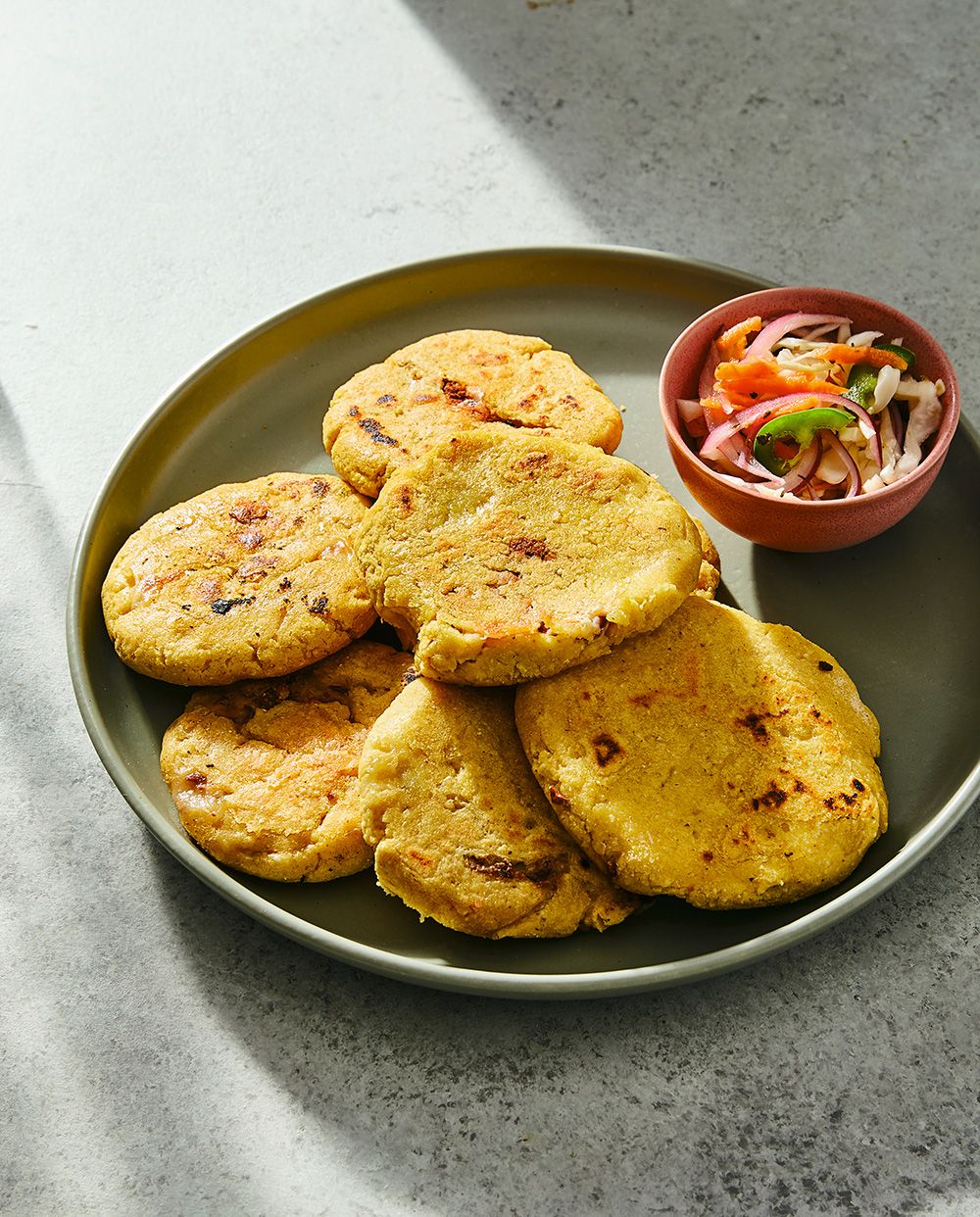
Filled Masa Flatbreads with Cabbage Slaw
Makes:
8 pupusas; serves 4
Curtido:
1/4 head green cabbage, shredded
1 small carrot, peeled and grated
1/2 small red onion, thinly sliced
1 small jalapeño chili, sliced and seeded, if desired
4 cups boiling water
1/4 cup distilled white vinegar
1 tsp kosher salt
1 tsp dried oregano
Dough:
2 cups instant masa harina (such as Maseca brand)
1 1/2 tsp kosher salt
1 1/2 cups warm water
Filling:
2 tbsp lard or vegetable oil
1/2 small yellow onion, finely chopped
2 cups cooked and drained red beans (such as kidney)
1 tsp kosher salt
1 cup water
1 cup shredded quesillo cheese
Vegetable oil for your hands and the griddle
Step 1
To make the curtido:
In a large heatproof bowl, combine the cabbage, carrot, red onion and chili. Pour in the boiling water, cover the bowl with a large plate, and let sit for 15 minutes. Drain well into a colander, then wipe the bowl dry and return the cabbage mixture to it. Add the vinegar, salt and oregano and stir and toss to mix well. Cover and refrigerate until chilled and the flavours are blended, at least 1 hour or preferably overnight.
Step 2
To make the dough:
In a large bowl, combine the masa harina and salt and stir and toss with a fork to mix well. Drizzle in the water and mix and toss with your hands until the mixture comes together in a stiff dough. Turn the dough out onto a work surface and knead until it is smooth, not sticky, just until it comes together. Wrap the dough in plastic wrap or a kitchen towel and let rest at room temperature while you make the filling. (The dough can also be made in a stand mixer fitted with the paddle attachment.)
Step 3
To make the filling:
In a medium skillet, heat the lard over medium-low heat. Add the onion and cook, stirring occasionally, until very brown, about 10 minutes. Add the beans, salt and water, bring to a simmer, and cook, stirring occasionally, until the beans are very creamy and start falling apart, about 10 minutes. Using a potato masher, mash the beans until smooth, then continue to cook, stirring, until very thick, 2 to 3 minutes more. Transfer to a bowl and let cool. Stir in the cheese, mixing well.
Step 4
To assemble, oil your hands and divide the dough into eight equal pieces. Roll each piece into a ball. Put a ball in the cupped palm of your non-dominant hand and, using your dominant hand, make a depression in the centre so the ball now resembles a candlestick. Fill the depression with about one-eighth of the filling and press the sides of the ball up and around to enclose the filling. Gently pat the dough into a round about 1/2 inch thick. Repeat with the remaining dough balls and filling. (If the dough cracks or breaks as you are shaping the rounds, just patch it. If a little filling is showing or leaking through, it’s not the end of the world.)
Step 5
Heat a griddle or a large cast-iron skillet over medium heat. When it is hot, brush it with oil. Working in batches to prevent crowding, lay the pupusas on the griddle and cook until golden brown on the underside, about 3 minutes. Flip and cook until the second side is golden brown, about 3 minutes more. Transfer to a platter. Repeat with the remaining pupusas.
Step 6
Serve the pupusas warm with the curtido in a bowl on the side.
PILI PILI
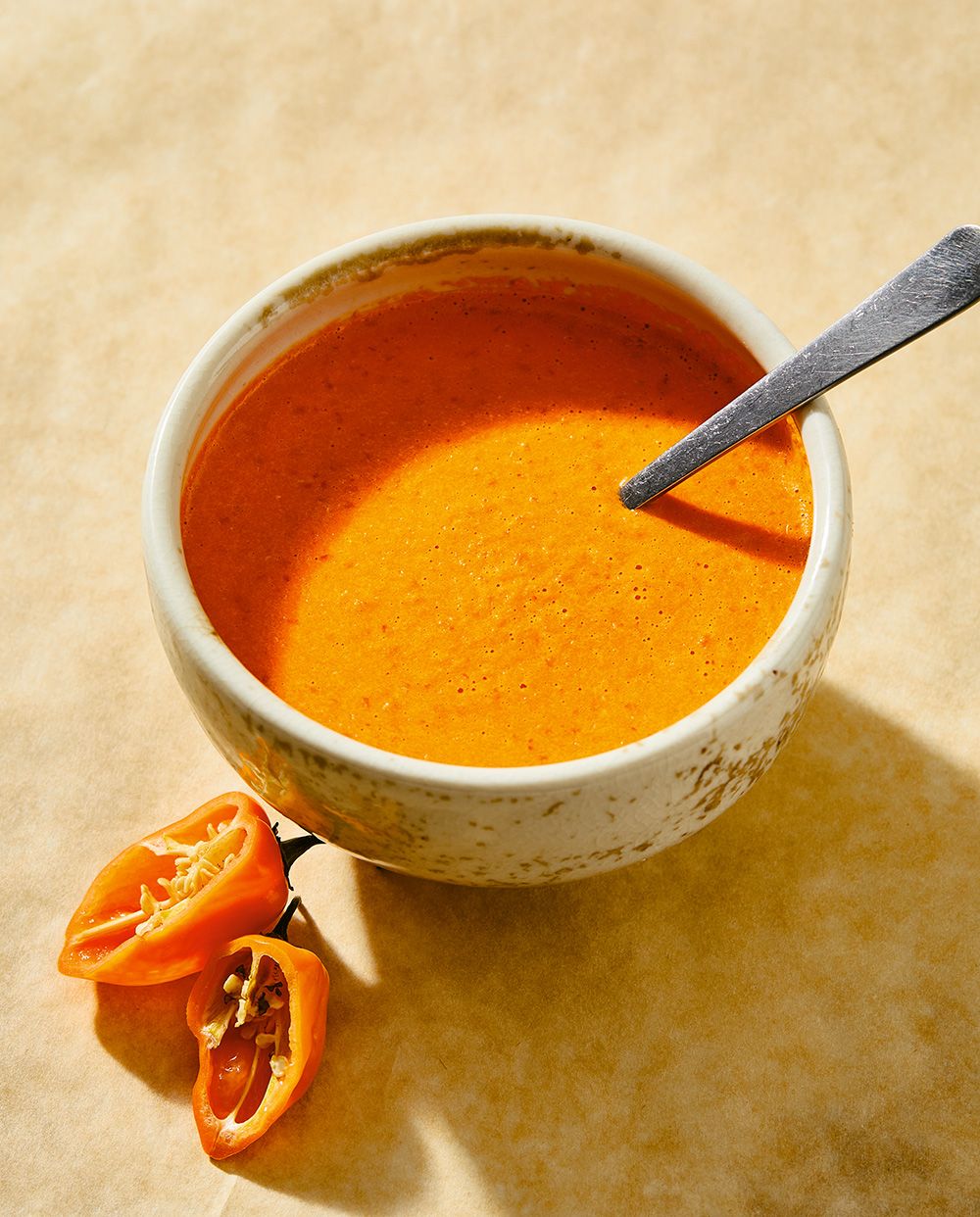
Hot Chili Sauce
Makes:
scant 1 cup
6 Scotch bonnet chilies
6 red jalapeño chilies
Juice of 1 lemon
3 garlic cloves
1-inch piece fresh ginger, peeled and sliced
1 tsp kosher salt
3 to 4 tbsp water
2 tbsp neutral oil (such as vegetable or canola)
Step 1
Wearing gloves, remove the stems from the Scotch bonnets and jalapeños and then remove the seeds, if desired. (The sauce will be much hotter if you leave the seeds in.)
Step 2
In a blender, combine all of the chilies, the lemon juice, garlic, ginger, salt and 3 tablespoons of the water and blend to make a thick paste, adding the remaining 1 tablespoon water if needed to move the blades. Add the oil and blend until you have a smooth sauce.
Step 3
Transfer the sauce to a tightly capped glass jar or other nonreactive container and refrigerate until ready to use.
Recipes and images reprinted with permission from
Setting a Place for Us
by Hawa Hassan, copyright ©2025. Published by Ten Speed Press, a division of Penguin Random House, LLC.
Our website is the place for the latest breaking news, exclusive scoops, longreads and provocative commentary. Please bookmark nationalpost.com and sign up for our cookbook and recipe newsletter, Cook This, here.


